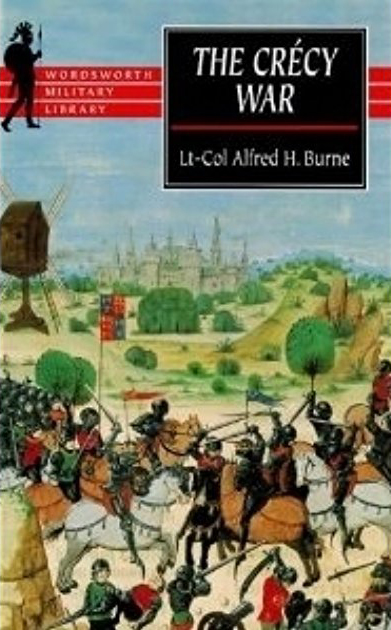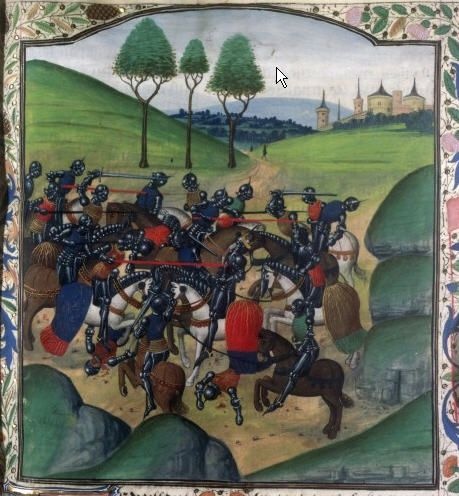What evidence is there for hilt bluing or blackening in the 15th century? Most artistic depictions I see show plain steel or yellow metal.
I'm looking at two French depictions of major battles from the Hundred Years War - one of the battle of Crecy (1346) the other of the battle of Agincourt (1415) - each appearing to show not just blued crosses & pommels on swords but also blued blades and blued or painted armor. I know of no reason to assume that the artists who painted these scenes invented the details concerning the coloration of the weapons and armor. Are you aware of similar artwork from the same approximate time period that shows weapons and armor 'in the white' as was the common fashion later in the 15th Century?
semi relevant, a lot of silvered/silver infused paints tarnish to black with time. Something in a bible plate or manuscript could have been bright metallic and have faded to a dark grey or black color.
| Tom King wrote: |
| semi relevant, a lot of silvered/silver infused paints tarnish to black with time. Something in a bible plate or manuscript could have been bright metallic and have faded to a dark grey or black color. |
All of the other pigments in these paintings appear fresh & bright, like new. I see no reason to assume that only the paints used to depict armor & arms would have darkened over time. The paintings were done at least 50 years apart so it can't be something unique to the palette of a single artist, either. Compare them to the artwork in the Maciejowski bible of approximately 1250 and it seems more likely that what we see today is what the artists wanted to portray.
| Steve Fabert wrote: | ||
All of the other pigments in these paintings appear fresh & bright, like new. I see no reason to assume that only the paints used to depict armor & arms would have darkened over time. The paintings were done at least 50 years apart so it can't be something unique to the palette of a single artist, either. Compare them to the artwork in the Maciejowski bible of approximately 1250 and it seems more likely that what we see today is what the artists wanted to portray. |
Unless, of course, the arms and armour are painted using an actual silver based pigment while the rest are not. Then we would expect precisely and only those to tarnish to black.
| T. Kew wrote: | ||||
Unless, of course, the arms and armour are painted using an actual silver based pigment while the rest are not. Then we would expect precisely and only those to tarnish to black. |
You assume that the artists had no clue that silver tarnishes to black. Anyone who has any experience with silver knows that it oxidizes to a black appearance. So a painter who assumed that real silver would look silver for more than a very short time would have to be pretty uninformed, wouldn't he? And you would have to assume that all of these various painters over the many decades spanned by these various paintings would all have to be similarly uninformed.
Or you could assume that various chemical treatments and/or paints were tried in the 14th & 15th Centuries to prevent armor from rusting. After all, that's why we use bluing, Parkerizing, and anodizing on firearms today. If these techniques were known back then it would make no sense for them not to be tried on valuable items like weapons & armor.
If it was really important to know it would be possible to do a spectrographic analysis of the paints used in these art works to confirm whether silver was used. It's not likely that any analysis of a 600 year old piece of hardware would reveal whether it once had a dark surface finish.
Black is not the only color depicted on medieval armor. Other finishes appear in works of art from the same epoch. Here's another depiction of Agincourt showing dark armor in the distance & much lighter copper/brass hardware in the forefront. The wounded individual in the lower right corner is shown in dark armor, which would appear to establish that the sorts of armor depicted rather than the pigments explain the different colors. Note the style of the horse, who seems to have been copied from one of the leaves of the Maciejowski Bible artwork..

Why would they have blued their hilts or armor ? Was there some advantage?
Christian - bluing is decorative and somewhat rust resistant. Sometimes it is treated as a decoration or a part of finishing armour, and it was definitely used on both armour and weapons in the early modern period. So it's possible that it was used on say, hilt furniture in the late middle ages. Some modern makers, such as arms and armour, offer blued hilts as an option. However, it can also be viewed differently - as a natural result of heat treatment (namely tempering after a full quench), where certain blue colors (peacock blue, perhaps some purples, less sure on that) actually correspond to the temperatures necessary to achieve a good temper. In this light, bluing is not an independent decorative addition but a natural byproduct of the heat treatment process that is left on afterwards for the sake of aesthetics and (limited) corrosion resistance. It would also not be clear why it would show up on a hilt in that case.
Regarding Froissart, I am well acquainted with the mid-15th century manuscript miniatures that render armoured and armed men entirely with blue-tinted armour and weapons. However, the sheer uniformity of the coloring seems to indicate that it is an artistic convention - that this is simply how some miniaturists paint steel. This is supported by the fact that in other media (oil painting, tapestries, polychrome sculpture) we do not see the profusion of blue-tinted armour that we do in certain manuscript miniatures.
As far as visual evidence, what I am actually looking for is a case where a hilt is colored blue but other steel surfaces are -not-, since that indicates that there is something special about that hilt. In cases where everything is blue-tinted, I think it that artistic evidence has to be seen as inconclusive, since it could be an artistic convention or the result of pigment degradation.
Regarding Froissart, I am well acquainted with the mid-15th century manuscript miniatures that render armoured and armed men entirely with blue-tinted armour and weapons. However, the sheer uniformity of the coloring seems to indicate that it is an artistic convention - that this is simply how some miniaturists paint steel. This is supported by the fact that in other media (oil painting, tapestries, polychrome sculpture) we do not see the profusion of blue-tinted armour that we do in certain manuscript miniatures.
As far as visual evidence, what I am actually looking for is a case where a hilt is colored blue but other steel surfaces are -not-, since that indicates that there is something special about that hilt. In cases where everything is blue-tinted, I think it that artistic evidence has to be seen as inconclusive, since it could be an artistic convention or the result of pigment degradation.
| William Knight wrote: |
|
As far as visual evidence, what I am actually looking for is a case where a hilt is colored blue but other steel surfaces are -not-, since that indicates that there is something special about that hilt. In cases where everything is blue-tinted, I think it that artistic evidence has to be seen as inconclusive, since it could be an artistic convention or the result of pigment degradation. |
I haven't looked exhaustively, but the two swords in the foreground of this depiction of the "Battle of the Herrings" in 1429 seem to display darker pommels & crosses compared to their blades, and certainly to show the swords in colors that differ from the darkened armor. https://en.wikipedia.org/wiki/Battle_of_the_Herrings
Obviously not every sword or suit of armor present at any gathering of medieval warriors would have been subjected to the same method of preservation. Any painting that shows every participant in a battle wearing identical gear is therefore following a convention. If blued, blackened, or painted armor was comparatively popular in France from 1350 to 1425 then painters familiar with the gear used in that time & place may not represent what was common in other locales or at other times.
Years ago Albion offered blued pommel/grip furniture. I still own a First Generation Crecy with a blued cross & pommel. A&A now offers blackened hardware (rather than blued) for an additional $85.

Just a note on the fading of pigments. If the hilts described above are made with silver leaf that will tarnish under certain conditions whereas other pigments remain just as bright as when they were first put down.
Folks,
I apologize for reviving this thread. I note, however, that none of the arguments here about whether tarnishing of silver-based pigments might result in the surfaces of metallic objects depicted in medieval art becoming black addresses the highlights painted on the objects. It seems plausible that where images are uniformly black, they may be covered with silver leaf or painted with silver-based pigment. But where there are white highlights on depictions of black items, it seems very unlikely that the paint colors have changed. It's hard to see how putting white highlights on silver (paint or leaf) would give the desired effect--that of brighter glints on an already shiny surface.
Best,
Mark Millman
I apologize for reviving this thread. I note, however, that none of the arguments here about whether tarnishing of silver-based pigments might result in the surfaces of metallic objects depicted in medieval art becoming black addresses the highlights painted on the objects. It seems plausible that where images are uniformly black, they may be covered with silver leaf or painted with silver-based pigment. But where there are white highlights on depictions of black items, it seems very unlikely that the paint colors have changed. It's hard to see how putting white highlights on silver (paint or leaf) would give the desired effect--that of brighter glints on an already shiny surface.
Best,
Mark Millman
Last edited by Mark Millman on Mon 03 Jul, 2023 5:42 am; edited 1 time in total
Chris Dobson's forthcoming book Beaten Black and Blue: The Myth of the Medieval Knight in Shining Armour may shed some light on some of this. I'm looking forward to my copy some time this summer.
Don't we have actual swords from that period with blackened hilt furniture in the 15th Century? A famous example is featured on this very site: http://myArmoury.com/feature_alexandria.html
There are various examples of tarnished silver in the Manesse codex:
[ Linked Image ]
The degree of preservation varies, and often tarnished silver will not only become black, but also smear.
[ Linked Image ]
The degree of preservation varies, and often tarnished silver will not only become black, but also smear.
Page 1 of 1
You cannot post new topics in this forumYou cannot reply to topics in this forum
You cannot edit your posts in this forum
You cannot delete your posts in this forum
You cannot vote in polls in this forum
You cannot attach files in this forum
You can download files in this forum
All contents © Copyright 2003-2006 myArmoury.com — All rights reserved
Discussion forums powered by phpBB © The phpBB Group
Switch to the Full-featured Version of the forum
Discussion forums powered by phpBB © The phpBB Group
Switch to the Full-featured Version of the forum

